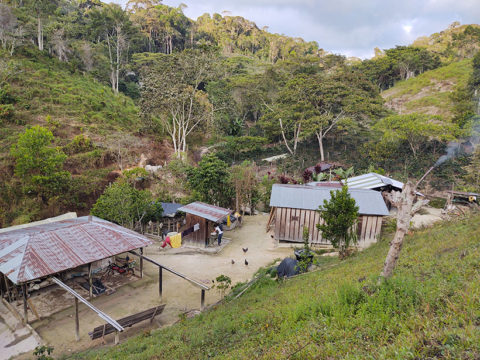Colombian coffee farmer Edgar Mendoza has been growing coffee on his 1.5-hectare farm in northern Colombia’s Serranía de San Lucas region for only 4 years, but he has already noticed that the climate is changing how he grows his crops.
“Climate change is obvious here,” he said. “There is an imbalance in the seasons, seasons with a lot of rain and other very dry seasons—even the winter and summer seasons are not fixed in place as before.”
This matches up with research in Ethiopia suggesting that climate change may radically redefine the regions best suited to growing coffee. Colombian scientists and farmers said the same is happening in their homeland, with some experts saying coffee production needs to be 150 meters of altitude higher for every degree of warming.
This is important because although coffee exports brought in $2.28 billion in 2019, coffee production in Colombia is done mainly on small family farms, where the harvest is taken in by a transient workforce, with each farmer having their own techniques and methods for producing the best possible cup of coffee, at the highest yield. With such an artisanal approach, the challenge of adaptation is huge.

In Mendoza’s words, the challenges for coffee growing are already “gigantic.”
“With the increase in temperature, the harvests would be scarce, since coffee requires a low temperature for the setting of its flowering; and if there is excess water, it also affects the harvest,” he said, adding that “environmental balance” is required.
“Now, if we have an increase in pests, we would have to use more pesticides, which translates into more pollution, more expensive production. Thus, coffee would cease to be a profitable crop,” Mendoza explained.
In Colombia’s second-biggest city, Medellín, Julián Gamboa is the impact manager at Urbania Cafe, a company that buys and roasts coffee, including beans from Serranía de San Lucas. Gamboa sees climate change as a real threat to the coffee supply chain.
“The yields are already lower, and the quality is reduced, and that really affects our supply chain because we work with small farmers who in general don’t have the means to invest a lot in their production,” Gamboa said. “So it really affects us and our small farmer allies.”
Although more and more people are becoming aware of the impacts of climate change, Gamboa said linking climate change to a consumer’s favorite drink is a good way to get the message across.
“We don’t think the average consumer is aware of how climate change is impacting coffee production,” he said. “Usually, people see climate change as a very abstract and faraway problem, and that’s definitely not the case with coffee.”
Gamboa said there’s an added element to all this: taste. The changes in temperature, rainfall, humidity, and other conditions that affect the terroir have a direct influence on the taste of the beverage, he said. Terroir describes the factors, including soil, climate, and sunlight, that affect a crop’s character and quality.
The terroir effect is strong enough that when the same coffee variety is planted at different altitudes and in different soils, the quality and flavor profiles will be different, according to a paper published in Scientific Reports that modeled the current and future suitability of specialty single-origin coffees in Ethiopia. The research also found that as specialty coffee loses production because of climate change, production would move into “generic (bitter) coffee categories in terms of quality profiles.”
Water and Soil
Carolina Ramírez, an agroclimatologist at Colombia’s National Coffee Research Center (Cenicafé), said water is key to the production of coffee and that climate change affects where, when, and how much rain falls.
The most suitable precipitation values for coffee cultivation in Colombia are between 1,400 and 2,900 millimeters per year, Ramírez explained, adding that the coffee plant has different water needs at different parts of its life cycle. For example, during flowering, it needs dry conditions, and during the production of fruit, it needs about 4 millimeters of rain per day.
Colombia is bordered to the west by the Pacific Ocean, and Ramírez said that changes in ocean temperature correlate with changes in rainfall in Colombia’s coffee-growing regions, part of the global climate cycle known as La Niña and El Niño.
“There are areas of the country where La Niña [wetter than usual conditions] represents a greater threat to coffee growing and others where El Niño [drier than usual conditions] is a greater threat,” she said.
Luz Lince, a soil scientist at Cenicafé, said that erosion and nutrient loss from waterlogged soils were two of the key threats to coffee from climate change.
“For good coffee production, the soil has to be alive: good drainage, microorganisms, organic material, and other ‘noble’ plants that help the coffee plants to thrive,” Lince said. “If the soil is full of water, the nutrients are not absorbed, or floods can wash away the soil.”

Lince said Cenicafé, “the NASA of coffee” founded by the Colombian Coffee Growers Federation, has been researching soil conditions for more than 80 years and has dozens of researchers working on coffee production, quality, pests, diseases, and conservation of natural resources in Colombia’s coffee regions.
“We already have many strategies, for example, planting coffee varieties that adapt well to certain locations,” Lince said. “We have to plant other tree species that conserve water and prevent erosion.”
Back in Serranía de San Lucas, coffee farmer Mendoza said that despite the challenges, he remains optimistic about the prospects of the coffee industry. “It is possible that the coffee-growing areas will be severely affected, but by establishing good shade systems in the coffee plantations and protecting the remaining forest, good production and quality can be maintained in the current areas,” he said.
—Andrew J. Wight (@ligaze), Science Writer
